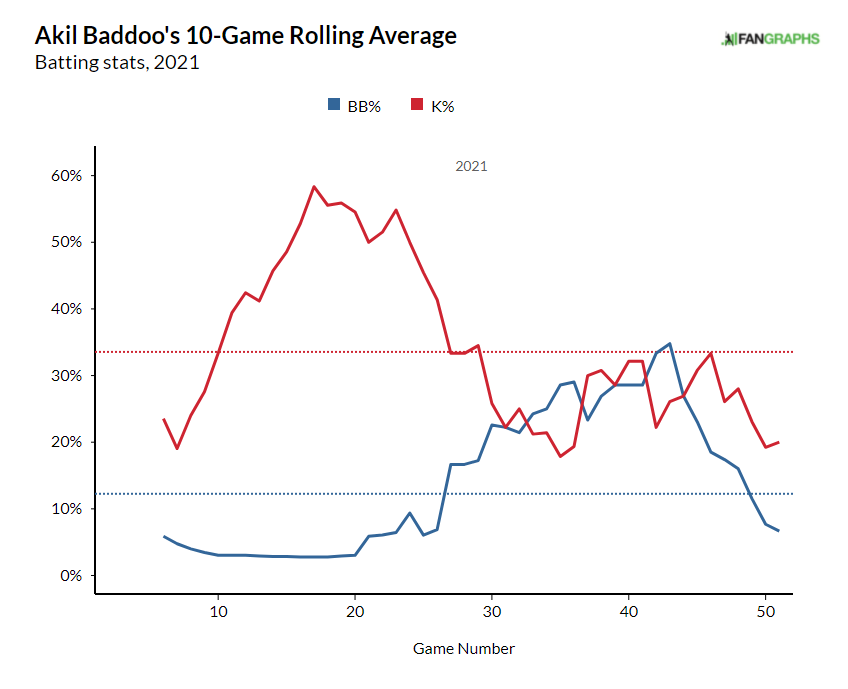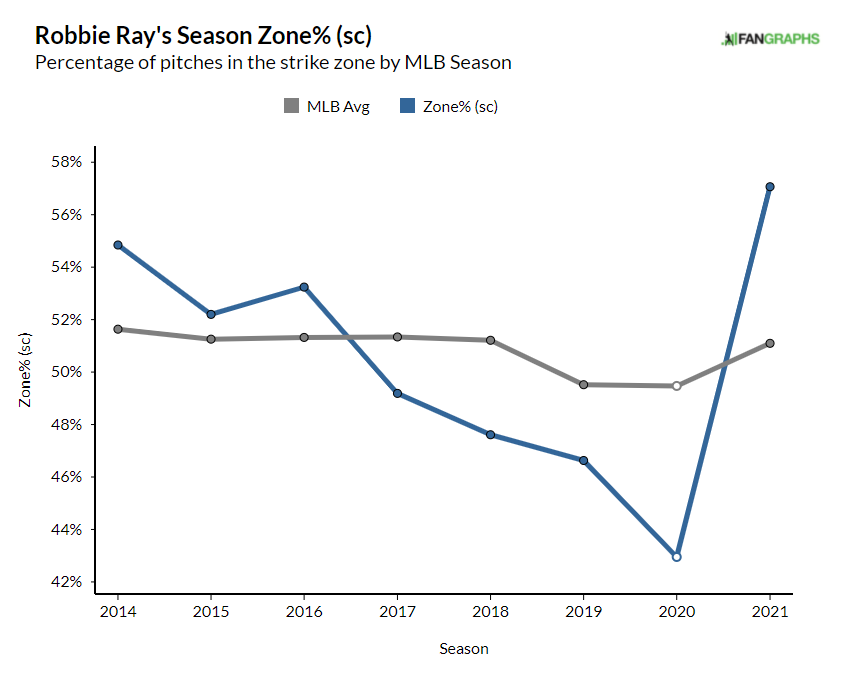Akil Baddoo Has Been Resilient Through the Ups and Downs
Few major leaguers can claim as exciting a debut week as Akil Baddoo had. On the first pitch he saw in the majors, he launched a 372 foot home run to the opposite field. The next day, he blasted a grand slam in the ninth inning of a blowout loss. The good vibes continued in his third major league game. After entering the game as a pinch runner in the eighth inning, Baddoo knocked in the game-winning run in the bottom of the 10th.
I often wonder what happens to rookies like Baddoo who make such a big splash in their debuts. How do they handle the inevitable failures they encounter in the big leagues? Baddoo’s first couple of steps in the majors were fantastic, but it’s the third, fourth, and fifth steps that so often trip up players trying to establish themselves at the highest level.
The tough reality of playing in the majors quickly brought Baddoo back down to earth. He launched another pair of home runs in back-to-back games a week after his extra-inning heroics, but soon began to struggle to handle big league pitching. Those struggles shouldn’t be all that surprising. After all, Baddoo had played just 29 games above Single-A during his short minor league career. Tommy John surgery wiped out most of his 2019 season in High-A and the pandemic prevented him from getting on the field in any professional capacity last year. Nonetheless, the Tigers selected him from the Minnesota Twins in the Rule 5 draft based on his toolset and potential alone.
But as you might expect for any 22-year-old with just over 1,000 professional plate appearances under his belt, Baddoo soon found himself flailing against the best the sport has to offer. On May 18, he reached 100 plate appearances on the season. On that date, his season slash line sat at .222/.287/.478 with an ugly strikeout rate touching nearly 40%. After the first two weeks of the season, when he slugged seven extra base hits in nine games, he collected just 10 total hits across the next 23 games, only five of which went for extra bases.
Baddoo has always shown an excellent understanding of the strike zone. His minor league walk rate was 13.7%, and in his only other full season as a professional (2018), he walked 14.3% of the time in Single-A. While that keen batting eye resulted in plenty of walks, it didn’t necessarily prevent him from developing significant holes in his swing. His minor league strikeout rate was 22.7% but much of that overall rate is pulled down by his excellent showing in rookie ball in 2017. During the last two seasons of his minor league career, his strikeout rate rose — to 24.0% in 2018 and 29.8% in ’19.
Making the adjustment to major league pitching is a tough task for any prospect, and most are making the transition from Triple-A with far more experience under their belts. Baddoo made the jump from High-A, with more than a year and a half between professional appearances complicating matters even further. These struggles were expected, but the true measure of his resilience is how Baddoo has adjusted. Over the 20 games and 58 plate appearances since May 18, Baddoo has compiled a .333/.448/.521 slash line and his strikeout rate has fallen to just 20.7%.
Here’s how he described how he approached his adjustments to Chris McCosky of The Detroit News:
“Really, it’s just having a game plan and sticking to what got you here. It’s just about staying mentally strong throughout the whole process. There’s been a lot of ups and downs, but I just took what the coaches and the veteran players were giving me and I made my own routine, my own plan on how to attack the game of baseball.”
Here’s a look at his 10-game rolling strikeout and walk rates this season:

After about a month of exposure to major league pitching, Baddoo made some significant changes to his approach that resulted in a dramatic decrease in his strikeout rate and an increase in his walk rate.
If we use May 18 as a breakpoint in his season, giving us 100 plate appearances in the first period and just under 60 in the second, we see some significant improvements in all of Baddoo’s plate discipline metrics.
| Period | PAs | O-Swing% | Z-Swing% | Z-Contact% | Contact% | SwStr% |
|---|---|---|---|---|---|---|
| Apr 1–May 18 | 101 | 25.6% | 67.0% | 65.5% | 59.7% | 18.6% |
| May 18–Jun 16 | 58 | 21.8% | 64.5% | 75.4% | 70.5% | 12.4% |
He’s cut his chase rate and improved his contact rate, thereby reducing his rate of swinging strikes. His contact rate is still something to worry about; even in its improved state, it sits below league average. That was a big concern while he was a prospect in the Twins organization. A bit of swing-and-miss will always be a part of his game, but if he’s making enough solid contact and getting on base often enough, he might be able to mitigate that part of his offensive profile.
The walks have certainly come as the season has progressed but the results on contact have been a bit more mixed.
| Period | K% | BB% | ISO | Hard Hit% | Barrel% | xwOBAcon | wRC+ |
|---|---|---|---|---|---|---|---|
| Apr 1–May 18 | 39.6% | 8.9% | 0.256 | 40.4% | 13.5% | 0.446 | 103 |
| May 18–Jun 16 | 20.7% | 17.2% | 0.188 | 22.2% | 8.3% | 0.440 | 166 |
Even though Baddoo’s overall offensive contributions have been far more valuable over his last 60 plate appearances, the quality of contact he’s made has been decidedly worse. His hard hit rate has fallen precipitously though his expected wOBA on contact has stayed steady. Instead of making solid contact and driving the ball, he’s been thriving on weakly hit flares and groundballs finding holes. During his surge over the last month, his BABIP has been .429 despite all of the weaker contact.
We’re working with a total sample of just 159 plate appearances and trying to glean some evidence of improvement over the last 60 PAs. It’s not much to work with and it may amount to nothing at all. Opponents will inevitably adjust their approach and Baddoo will face a new challenge when they do. But it is encouraging to see some of the tools he featured as a prospect materialize in the majors after they were largely absent during the first month of the season.
The Tigers have also diligently protected him on the strong side of an outfield platoon. He’s compiled all of 27 plate appearances against left-handed pitching so far and has been completely neutralized. That was the profile scouts had envisioned for him as a prospect, and Detroit’s outfield is in a state where they have little to loose to see if Baddoo can reach or exceed that ceiling.
The changes Baddoo has made to his approach bring his excellent pitch discernment to bear and have paid dividends, but he’s far from a finished product. He needs to find a way to reincorporate that penchant for solid contact he displayed during the first two weeks of his major league career. His confidence and drive were big reasons why the Tigers felt comfortable taking such a raw player in the Rule 5 draft. He’s learning on the fly how to overcome failure without the option to return to the minor leagues to work on things in a low pressure environment. That kind of resiliency isn’t easy to maintain, but Baddoo hasn’t let the big stage get to him yet.
“Once I stop smiling, we’ve got a problem,” he said to McCosky. “When I’m smiling, we’re good to go.”

